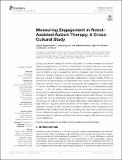| dc.contributor.author | Lee, Jaeryoung | |
| dc.contributor.author | Mascarell-Maricic, Lea | |
| dc.contributor.author | Schuller, Björn W. | |
| dc.contributor.author | Rudovic, Ognjen | |
| dc.contributor.author | Picard, Rosalind W. | |
| dc.date.accessioned | 2018-06-25T15:24:04Z | |
| dc.date.available | 2018-06-25T15:24:04Z | |
| dc.date.issued | 2017-07 | |
| dc.date.submitted | 2017-02 | |
| dc.identifier.issn | 2296-9144 | |
| dc.identifier.uri | http://hdl.handle.net/1721.1/116558 | |
| dc.description.abstract | During occupational therapy for children with autism, it is often necessary to elicit and maintain engagement for the children to benefit from the session. Recently, social robots have been used for this; however, existing robots lack the ability to autonomously recognize the children’s level of engagement, which is necessary when choosing an optimal interaction strategy. Progress in automated engagement reading has been impeded in part due to a lack of studies on child-robot engagement in autism therapy. While it is well known that there are large individual differences in autism, little is known about how these vary across cultures. To this end, we analyzed the engagement of children (age 3–13) from two different cultural backgrounds: Asia (Japan, n = 17) and Eastern Europe (Serbia, n = 19). The children participated in a 25 min therapy session during which we studied the relationship between the children’s behavioral engagement (task-driven) and different facets of affective engagement (valence and arousal). Although our results indicate that there are statistically significant differences in engagement displays in the two groups, it is difficult to make any causal claims about these differences due to the large variation in age and behavioral severity of the children in the study. However, our exploratory analysis reveals important associations between target engagement and perceived levels of valence and arousal, indicating that these can be used as a proxy for the children’s engagement during the therapy. We provide suggestions on how this can be leveraged to optimize social robots for autism therapy, while taking into account cultural differences. | en_US |
| dc.description.sponsorship | MEXT Grant-in-Aid for Young Scientists B (grant no. 16763279) | en_US |
| dc.description.sponsorship | Chubu University Grant I (grant no. 27IS04I (Japan)) | en_US |
| dc.description.sponsorship | European Union. HORIZON 2020 (grant agreement no. 701236 (ENGAGEME)) | en_US |
| dc.description.sponsorship | European Commission. Framework Programme for Research and Innovation. Marie Sklodowska-Curie Actions (Individual Fellowship) | en_US |
| dc.description.sponsorship | European Commission. Framework Programme for Research and Innovation. Marie Sklodowska-Curie Actions (grant agreement no. 688835 (DE-ENIGMA)) | en_US |
| dc.publisher | Frontiers Media SA | en_US |
| dc.relation.isversionof | http://dx.doi.org/10.3389/FROBT.2017.00036 | en_US |
| dc.rights | Creative Commons Attribution 4.0 International License | en_US |
| dc.rights.uri | http://creativecommons.org/licenses/by/4.0/ | en_US |
| dc.source | Frontiers | en_US |
| dc.title | Measuring Engagement in Robot-Assisted Autism Therapy: A Cross-Cultural Study | en_US |
| dc.type | Article | en_US |
| dc.identifier.citation | Rudovic, Ognjen, Jaeryoung Lee, Lea Mascarell-Maricic, Björn W. Schuller, and Rosalind W. Picard. “Measuring Engagement in Robot-Assisted Autism Therapy: A Cross-Cultural Study.” Frontiers in Robotics and AI 4 (July 27, 2017). | en_US |
| dc.contributor.department | Program in Media Arts and Sciences (Massachusetts Institute of Technology) | en_US |
| dc.contributor.mitauthor | Rudovic, Ognjen | |
| dc.contributor.mitauthor | Picard, Rosalind W. | |
| dc.relation.journal | Frontiers in Robotics and AI | en_US |
| dc.eprint.version | Final published version | en_US |
| dc.type.uri | http://purl.org/eprint/type/JournalArticle | en_US |
| eprint.status | http://purl.org/eprint/status/PeerReviewed | en_US |
| dc.date.updated | 2018-06-21T14:46:51Z | |
| dspace.orderedauthors | Rudovic, Ognjen; Lee, Jaeryoung; Mascarell-Maricic, Lea; Schuller, Björn W.; Picard, Rosalind W. | en_US |
| dspace.embargo.terms | N | en_US |
| dc.identifier.orcid | https://orcid.org/0000-0002-5661-0022 | |
| mit.license | PUBLISHER_CC | en_US |
